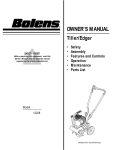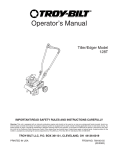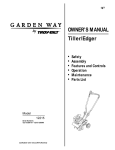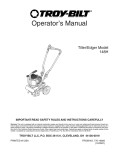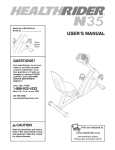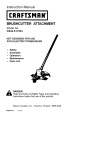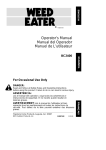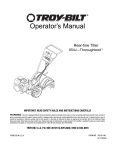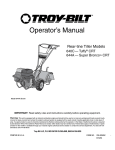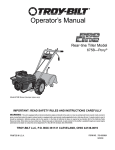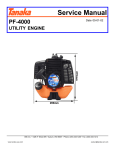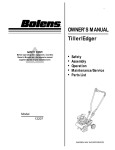Download Troy-Bilt 12235 Tiller User Manual
Transcript
OWNER’S MANUAL Tiller/Edger SAFETY FIRST! Before operating this equipment, read this Owner's Manual and the separate manual supplied by the engine manufacturer. • • • • • • Safety Assembly Features and Controls Operation Maintenance Parts List Model 12235 GARDEN WAY INCORPORATED Dear Owner: Congratulations on your purchase of a Tiller/Edger. It has been designed, engineered and manufactured to give you the best possible dependability and performance. Please carefully read this Manual which provides information on how to safely and easily set-up, operate and maintain your machine. Be sure that you and any other operators carefully follow the recommended safety practices at all times. Failure to do so could result in personal injury or property damage. If you should ever have any problems or questions, please contact your local authorized service dealer or call the Factory. See the back cover of this Manual for Customer Service information. We want to be sure that you are completely satisfied at all times. See Back Cover for Customer Service Information Safety Alert Symbol SECTION 1: SAFETY ........................................... Training....................................................................... Preparation ................................................................. Operation.................................................................... Maintenance/Storage.................................................. 3 3 3 4 4 SECTION 2: ASSEMBLY ........................................ Unpacking Instructions............................................... Assembly Steps .......................................................... 5 5 5 SECTION 3: FEATURES AND CONTROLS ..................... 7 SECTION 4: OPERATION ...................................... 8 Pre-start Preparation .................................................. 8 Stopping and Starting the Engine ............................... 8 Tilling and Cultivating ................................................. 9 Attachments ............................................................... 10 SECTION 5: MAINTENANCE .................................. Equipment Maintenance ............................................. Engine Maintenance ................................................... Tine Removal and Installation..................................... Storage ....................................................................... Troubleshooting.......................................................... Safety and Operating Decals....................................... 11 11 11 12 13 14 14 PARTS LIST ..................................................... 15 This is a safety alert symbol. It is used in this manual and on the unit to alert you to potential hazards. When you see this symbol, read and obey the message that follows it. Failure to obey safety messages could result in personal injury or property damage. This machine meets voluntary safety standard B71.8 – 1996, which is sponsored by the Outdoor Power Equipment Institute, Inc., and is published by the American National Standards Institute. WARNING The engine exhaust from this product contains chemicals known to the State of California to cause cancer, birth defects or other reproductive harm. 2 Table of Contents INDEX ............................................................ 19 CUSTOMER SERVICE INFORMATION.............. BACK COVER WARNING TO AVOID INJURY: • READ THE OPERATOR’S MANUAL. • KNOW LOCATION AND FUNCTION OF ALL CONTROLS. • KEEP ALL SAFETY DEVICES AND SHIELDS IN PLACE AND WORKING. • NEVER ALLOW CHILDREN OR UNINSTRUCTED ADULTS TO OPERATE MACHINE. • SHUT OFF ENGINE AND DISCONNECT SPARK PLUG WIRE BEFORE MANUALLY UNCLOGGING TINES OR MAKING REPAIRS. • KEEP BYSTANDERS AWAY FROM MACHINE. • KEEP AWAY FROM ROTATING PARTS. • USE EXTREME CAUTION WHEN REVERSING OR PULLING THE MACHINE TOWARDS YOU. Section 1 Safety SPARK ARRESTER WARNING TO RESIDENTS OF CALIFORNIA AND SEVERAL OTHER STATES Under California law, and under the laws of several other states, you are not permitted to operate an internal combustion engine using hydrocarbon fuels on any forest, brush, hay, grain, or grass covered land; or land covered by any flammable agricultural crop without an engine spark arrester in continuous effective working order. The engine on the unit is an internal combustion engine which burns gasoline, a hydrocarbon fuel, and must be equipped with a spark arrester muffler in continuous effective working order. The spark arrester must be attached to the engine exhaust system in such a manner that flames or heat from the system will not ignite flammable material. Failure of the owner/operator of the unit to comply with this regulation is a misdemeanor under California law (and other states) and may also be a violation of other state and/or federal regulations, laws, ordinances or codes. Contact your local fire marshal or forest service for specific information about which regulations apply in your area. TRAINING • Read this Owner’s Manual and the separate Engine Owner’s Manual very carefully before operating this equipment. Be completely familiar with the controls and the proper use of the equipment. Know how to stop the unit and disengage the controls quickly. A replacement Manual is available by contacting your authorized dealer or the Factory. • Never allow children or untrained adults to use this equipment. Let adults operate the unit only if instructed properly. • Keep the area of operation clear of all persons, particularly small children and pets. Keep bystanders at least 25 feet from the area of operation. • Keep in mind that the operator or user is responsible for accidents or hazards occurring to other people, their property and themselves. • Familiarize yourself with all of the safety and operating decals on this equipment and on any of its attachments or accessories. • Do not run engine in an enclosed area. Engine exhaust contains carbon monoxide gas, a deadly poison that is odorless, colorless, and tasteless. Do not operate this equipment near buildings, windows, or air conditioning equipment. • Do not allow hands or any other part of the body or clothing near the rotating tines or near any other moving part. The tines begin to rotate forward once the engine is started and the Throttle/Tines Lever is squeezed. The tines continue to rotate until the operator releases the Throttle/Tines Lever. • Before inspecting or servicing any part of the equipment, shut off engine, make sure all moving parts have come to a complete stop, then disconnect spark plug wire from spark plug and move wire away from the plug. • Do not operate this equipment if you are under the influence of alcohol, medication, or when you are tired or ill. PREPARATION • Thoroughly inspect the area where the equipment is to be used and remove all foreign objects. • Make sure that the Throttle/Tines Lever is released and is in the neutral position before you begin to start the engine. • Do not operate the machine without wearing adequate outer garments. Avoid loose garments or jewelry that could get caught in moving parts of the machine or its engine. • Do not operate the equipment when barefoot or when wearing sandals, sneakers, or similar lightweight footwear. Wear protective footwear that will protect your feet and improve footing on all surfaces. • Wear approved safety glasses when operating this equipment. The operation of any powered machine can result in foreign objects being thrown by high-speed rotating parts. • Do not till near underground electric cables, telephone lines, pipes, or hoses. If in doubt, contact your utility or telephone company to locate underground services. • Handle fuel with care. It is highly flammable and has explosive vapors. Take these precautions: a. Use an approved fuel container. b. Add fuel before starting the engine. Never remove the cap of the fuel tank or add fuel while the engine is running or when the engine is hot. Operators shall not smoke. c. Keep matches, cigarettes, cigars, pipes, open flames, and sparks away from the fuel tank and fuel container. d. Fill fuel tank outdoors and with extreme caution. Never fill fuel tank when indoors. Use a funnel or spout to prevent spillage. e. Replace all fuel tank and fuel container caps securely. f. If fuel is spilled, do not attempt to start the engine, but move the machine away from the area of spillage and avoid creating any source of ignition until fuel vapors have dissipated. • Never make adjustments to your equipment when the engine is running or spark plug wire is connected (unless specifically recommended in Owner’s Manual). Operator’s Position RIGHT SIDE LEFT SIDE LEFT and RIGHT sides of the tiller are from the operator’s position behind the handlebar (unless noted otherwise). OPERATION • The correct operator’s position is when you are standing behind and gripping handlebar, facing forward toward the engine. Do not leave this position while using the Throttle/Tines Lever. 3 Section 1: Safety • Do not put hands or feet near or under rotating parts. • Exercise extreme caution when on or crossing gravel drives, walks or roads. Stay alert for hidden hazards or traffic. Do not carry passengers. • After striking a foreign object, stop the engine, let all moving parts come to a complete stop, disconnect the spark plug wire and prevent it from touching the spark plug, then carefully inspect the machine for damage. Repair the damage before restarting and operating the machine. • Exercise caution to avoid slipping or falling. • If the machine should start to vibrate abnormally, stop the engine. Disconnect the spark plug wire and prevent it from touching the plug. Check immediately for the cause. Vibration is generally a warning of trouble. Fix the problem before using the equipment again. • Stop the engine, disconnect the spark plug wire and prevent it from touching the spark plug whenever you leave the equipment, before unclogging the tines, or when making any repairs, adjustments or inspections. • Take all possible precautions when leaving the machine unattended. Always stop the engine. Disconnect the spark plug wire and prevent it from touching the plug. • Before cleaning, repairing, or inspecting, stop the engine and make certain all moving parts have stopped. Disconnect the spark plug wire and prevent it from touching the spark plug to avoid accidental starting. • Never operate equipment without proper guards, plates, or other protective safety devices in place. • Do not run the engine in an enclosed area. The exhaust fumes from the engine contain extremely dangerous carbon monoxide gas. This gas is colorless, odorless, tasteless and deadly poisonous. • Keep children and pets away. 4 • Be aware that the equipment may unexpectedly bounce upward or jump forward if the tines should strike extremely hard packed soil, frozen ground, or buried obstacles such as large stones, roots or stumps. If you are in doubt about the tilling conditions, always use the following operating precautions to assist you in maintaining control of the equipment: a. Stand behind the equipment, using both hands on the handlebar. Relax your arms, but use a secure hand grip. b. Start tilling at shallow depths, working gradually deeper with each pass. c. Clear the tilling area of all large stones, roots, and other debris. d. In an emergency, stop the tines by releasing the Throttle/Tines Lever on the handlebar. To stop the engine, move the engine On/Off switch to OFF. • Do not overload the machine’s capacity by attempting to till too deeply at too fast a rate. • Never operate the equipment on slippery surfaces. Look behind and use care when backing up. • Do not operate the equipment on a slope that is too steep for safety. When on slopes, slow down and make sure you have good footing. • Never allow bystanders near the unit. • Only use attachments and accessories that are factory-approved. • Never operate the equipment without good visibility or good light. • Never operate the unit if you are tired, or under the influence of alcohol, drugs, or medication. • Do not tamper with the engine governor settings on the machine; the governor controls the maximum safe operating speed and protects the engine and all other moving parts from damage caused by engine overspeed. Authorized service shall be sought if a problem exists. • Do not touch engine parts which may be hot from operation. Allow parts to cool before inspecting, cleaning or repairing. • Remember: you can stop the tines by releasing the Throttle/Tines Lever. Move the engine On/Off switch to OFF to shut the engine off. • Never transport this machine when the engine is running. • Terminals and non-insulated electrical parts shall be protected against shorting during normal servicing, refueling or lubrication. • Use extreme caution when reversing or pulling the machine toward you. • Start the engine carefully according to instructions and with feet well away from the tines. MAINTENANCE/STORAGE • Keep the tiller, attachments and accessories in safe working condition. • Check all nuts, bolts, and screws at frequent intervals for proper tightness to be sure equipment is in safe working condition. • Never store equipment with fuel in fuel tank inside a building where fumes may reach an open flame or spark (hot water and space heaters, furnaces, clothes dryers, stoves, electric motors, etc.). • Allow the engine to cool before storing the equipment. • Keep the engine free of grass, leaves, or grease to reduce the chance of a fire hazard. • Store gasoline in a cool, well-ventilated area, safely away from any spark- or flame-producing equipment. Store gasoline in an approved container, safely away from the reach of children. • Never perform maintenance when engine is running or spark plug wire is connected unless instructed to do so. • If fuel tank must be drained, do so outdoors. • Follow manufacturer’s recommendations for safe loading, unloading, transport and storage of machine. Section 2 Assembly STEP 2: Inspect and Tighten Hardware WARNING To prevent personal injury or property damage, do not start the engine until all assembly steps are complete and you have read and understand the safety and operating instructions in this manual. Check all nuts, bolts and screws on your unit and tighten as needed. NOTE: Use a 7/16" socket with an extension to check hardware at ends of handlebar. B C WARNING Contact with rotating tines or other moving parts can cause serious personal injury. Before installing or removing attachments, or adjusting or servicing the machine, stop the engine, let all moving parts come to a complete stop, disconnect the spark plug wire and move the wire away from the spark plug. INTRODUCTION Read these instructions in their entirety before you attempt to assemble or operate your new equipment. IMPORTANT: The correct mixture of unleaded automotive gasoline and two-cycle motor oil (a 24:1 ratio of gasoline to twocycle oil) must be added to the fuel tank before starting the engine. See instructions in this Section. UNPACKING INSTRUCTIONS 1. Inspect your machine immediately. If you find or suspect damage to the carton or contents, contact your local authorized dealer or the Factory for assistance. 2. Remove any packing material. Check for small parts before discarding the packing material. 3. Loose parts include the following: (2) Long Bushings (Packed in a separate plastic bag) 4. Perform the assembly on a clean, level surface. Be careful not to severely bend any of the control cables on the unit. 5. Before starting any assembly steps, disconnect the engine spark plug wire from the spark plug. A C A C Figure 1: Loosen handlebar knobs and unfold handlebar. Slide plastic ties to the locations shown. ASSEMBLY STEPS STEP 1: Unfold and Adjust Handlebar IMPORTANT: Be careful not to pinch any wires or cables while unfolding and adjusting the handlebar. 1. Loosen the two handlebar knobs (A, Figure 1) and unfold the handlebar into the operating position. Do not use force — if there is binding, continue to loosen the knobs. 2. There are two height settings holes in the upper handlebar. The unit is shipped with the handlebar knobs in the lowest height setting holes. If this height is correct for you, simply tighten the two handlebar knobs. If a higher setting is desired, reposition the handlebar knobs, mounting screws and washers in the other set of holes. 3. Check the locations of the three plastic ties (C, Figure 1). The ties must be positioned as shown. NOTE: There is just one handlebar storage position – folded over the engine as originally shipped. Tools Needed to Check for Loose Hardware: • Adjustable wrench • Slotted-head screwdriver • Phillips-head screwdriver • 7/16" socket and extension IMPORTANT: Do not tighten engine governor screw (D, Figure 2). It is factoryadjusted for proper engine operation. D Figure 2: Do not adjust or tighten the engine governor screw. DANGER • Gasoline and its vapors are highly flammable and explosive. Keep gasoline away from possible ignition sources. • Do not smoke while mixing the gasoline and two-cycle oil together or when filling the fuel tank. • Never fill fuel tank when engine is running or hot. Failure to follow these precautions could result in the fuel igniting, causing personal injury or property damage. STEP 3: Add a Mixture of Gasoline and Two-Cycle Oil to the Fuel Tank IMPORTANT: Read the separate Engine Owner’s Manual before starting the engine. 1. Use clean, high quality 2-cycle oil, NMMA TC-WII or TC-W3. DO NOT USE MULTI-VISCOSITY OIL! 2. Use fresh, clean, unleaded regular, unleaded premium or reformulated automotive gasoline only. DO NOT USE LEADED GASOLINE. 5 Section 2: Assembly Chart 1: FUEL MIXTURE (Mixture Ratio is 24 parts gasoline to 1 part two-cycle oil) U.S. Gas U.S. Oil 1 Gal. 2 Gal. Metric Petrol 5 oz. 11 oz. Metric Oil 4 liters 8 liters 167 ml 333 ml NOTE: Do not use gasoline containing methanol (wood alcohol). Fuel containing up to 10% ethanol (gasohol) or up to 15% MTBE (Methyl Tertiary Butyl Ether) may be used, but requires special care when the engine is not used for extended periods. See “STORAGE” instructions in Engine Owner’s Manual for additional information. 3. The fuel/oil mix ratio is 24:1 with the use of a NMMA classified oil. For new engines, use twice the normal oil quantity for the first gallon of fuel. NOTE: Due to differences in fuel and oil availability worldwide, Tecumseh recommends a 16:1 mix ratio if NMMA oil is not available. 6 4. Do not mix fuel directly in engine fuel tank. Always use a clean, safety-approved fuel container. • To Mix: A. Fill a clean, approved container one quarter full with recommended gasoline. B. Add recommended amount of oil per Chart 1: FUEL MIXTURE. C. Screw cap on container and shake vigorously. Then unscrew cap and fill container with gasoline per Chart 1: FUEL MIXTURE. Screw on cap and shake again. Once mixed, oil and gasoline will not separate. • To Fill Fuel Tank: A. Engine must be cool. Clean area around fuel tank cap and remove cap. Insert a clean funnel into the fuel tank. B. Slowly pour gasoline/oil mixture into fuel tank. Fill tank no higher than 1/2" from top of tank to allow for gasoline expansion. Install fuel cap and clean up any fuel spills. Section 3 Features and Controls KNOW YOUR EQUIPMENT READ THIS OWNER’S MANUAL AND ALL SAFETY RULES BEFORE OPERATING YOUR EQUIPMENT. Know the location and function of all features and controls on the equipment. Save this manual for future reference. TILLER/EDGER CONTROLS WARNING Before operating your machine, carefully read and understand all safety, controls, and operating instructions in this Manual, the separate Engine Owner’s Manual and on the decals on the machine. Failure to follow these instructions can result in serious personal injury. Handlebar Height Adjustment Knob (B, Figure 5) Two height settings, plus a storage position are available. Refer to Assembly Steps, STEP 1 in Section 2 for adjustment instructions. Tilling Depth Adjustment Knob (C, Figure 5) Loosening the knob enables you to move the wheel bracket (K) up or down on the height adjustment bar (L). This controls the tilling depth. IMPORTANT: Do not move the wheel bracket any higher than the top of the adjustment bar. Adjustable Tine Patterns (D, Figure 5) The four tine sections are assembled at the factory for maximum performance under a wide variety of conditions. If needed, the tines can be arranged for narrower tilling or close cultivating. The tines can also be arranged to till very stony soil. See Adjusting Tine Patterns in Section 4 for details. G J Carrying Handle (E, Figure 5) When the handlebar is folded in the storage position the unit can be carried by the carrying handle. The carrying handle also serves as a tie-down anchor point. B Edger Attachment (Optional - not shown) An Edger Attachment is available to make clean, sharp edges next to walkways, driveways, paths, planted areas, patios, etc. See Attachments in Section 4 for more information. J E ENGINE CONTROLS B F J Engine On/Off Switch (A, Figure 5) Use the engine On/Off Switch to start or stop the engine. See Starting and Stopping the Engine in Section 4 and the Engine Owner’s Manual for details. C K L ENGINE DETAIL A M D Figure 5: Features and controls. Throttle/Tines Lever (G, Figure 5) Squeeze this lever to start tine rotation and to vary the tine speed. Release the lever to stop all tine motion. See Starting and Stopping the Engine in Section 4 for details. IMPORTANT: Do not squeeze this lever when starting the engine. Engine Recoil Start Rope (F, Figure 5) Use the recoil start rope to start the engine. See Starting and Stopping the Engine in Section 4 and the Engine Owner’s Manual for details. Fuel Primer Bulb (M, Figure 5) Use the fuel primer bulb to help start the engine under certain conditions. See Starting and Stopping the Engine in Section 4 and the Engine Owner’s Manual for details. 7 Section 4 Operation WARNING A Before operating the unit carefully read and understand all safety, control and operating instructions in this Manual, the separate Engine Owner’s Manual and the decals on the machine. Failure to follow these instructions can result in serious personal injury. PRE-START PREPARATION Before starting the engine, perform the following checks and services: 1. Disconnect the spark plug wire from the spark plug. 2. Move the engine On/Off switch to the OFF position. 3. Check the three plastic cable ties (J, Figure 5). Be sure that cables and ties are positioned as shown. Do not kink or pinch the control cables in the handlebar. 4. Adjust handlebar height to desired position (see Assembly Steps, STEP 1: in Section 2). 5. Check hardware for tightness. DANGER GASOLINE IS HIGHLY FLAMMABLE AND ITS VAPORS ARE EXPLOSIVE. Follow the gasoline safety rules in this Manual (Section 1) and in the separate Engine Owner’s Manual. Failure to follow gasoline safety instructions can result in serious personal injury and property damage. 6. Add the correct fuel mixture (see Assembly Steps, STEP 3: in Section 2). 7. Adjust the tilling depth as follows: a. Loosen tilling depth adjustment knob (A, Figure 6). b. Move wheel bracket (B, Figure 6) up in relation to the height adjustment bar (C). Moving the bracket upward results in shallower tilling, which is recommended for initial use. IMPORTANT: Do not move the wheel bracket any higher than the top of the adjustment bar. 8 B C High-Volume Priming Position Figure 6 c. Retighten the depth adjustment knob. 8. Reconnect the spark plug wire. STOPPING AND STARTING THE ENGINE Stopping the Engine To stop the engine, move the engine On/Off Switch (A, Figure 5) to the OFF position. WARNING Do not squeeze the Throttle/Tines Lever while starting engine. Tines may propel the machine forward if the engine speed is advanced from idle. Failure to comply can result in personal injury or property damage. Starting the Engine 1. Move engine On/Off Switch to ON. 2. Determine which of the next three starting conditions to use: First Time Starting: Use this starting method to start a new engine for the first time, or after running out of gas, or after extended storage. Use thumb and forefinger to squeeze the side of the primer bulb that is in line with the light colored rib on the primer body, as shown in Figure 7 (High-Volume Priming Position). Squeeze the primer bulb six (6) times. This process removes air from the priming system. As fuel enters the priming system, the priming action will feel more firm. Standard-Volume Priming Position Figure 7 Cold Starting: Use this starting method after the unit has been sitting or has been in brief storage, and has fuel in the tank. Use the Standard-Volume Priming Position (Figure 7) and push in top of primer bulb two (2) times for above 550F, or three (3) times if below 550F. Warm Starting: Do not use the primer to restart the engine after it has been stopped after running and has not cooled completely. 3. Stand with your feet positioned safely away from the tines (Figure 8). Hold the upper handlebar with one hand. Use the other hand to pull the recoil start rope out slowly until you feel resistance. Let rope rewind slowly. Then, quickly pull the rope all the way out. Do this up to ten (10) times. Let the start rope rewind slowly and completely each time. Allow the engine to warm Figure 8 up for several seconds. If engine either fails to start or to continue running, push in primer bulb two (2) times. Grasp starter rope and pull with a rapid, full stroke, up to ten (10) times. Section 4: Operation B A C Figure 9: “A” - all four tine gangs in standard pattern; “B” - two outer gangs removed for narrow tilling; “C” - the two inner gangs have been swapped for stony tilling conditions. TROUBLESHOOTING: Push the primer bulb in two (2) more times. Using a rapid full stroke, pull out the starting rope up to ten (10) times. If engine still does not start, wait 15 minutes. Do not prime engine further. Grasp start rope and pull with a rapid, full stroke up to ten (10) times. WARNING Keep away from rotating tines. Rotating tines will cause serious personal injury. TILLING AND CULTIVATING Use your machine to break up sod, prepare seedbeds and for cultivating in gardens and flower beds. It is easy to operate, but it is important that you start out slowly and read this Section thoroughly before putting it to use. Let the machine do most of the work. The tines will pull the machine forward, letting you adjust forward speed by pressing down or lifting the handlebar. 1. Roll the machine to the work area. 2. Adjust the tilling depth to the desired position (see Pre-Start Preparation, previous page). 3. Start the engine (see Stopping and Starting the Engine, previous page). Stand behind the handlebar and push down on thehandlebar to raise the tines off the ground. Squeeze the Throttle/Tines Lever– the engine should speed up and the tines start rotating. Release the Throttle/Tines Lever to return to idle, the tines should stop rotating or they may rotate very slowly. Lowering them back to the ground should stop any rotation. NOTE: If tines continue to rotate when engine is idling, either the idle speed is too high or the centrifugal clutch is malfunctioning. If this occurs, contact the Factory or your local authorized dealer. 4. Squeeze the Throttle/Tines Lever to start the tines rotating. Lower the tines to begin tilling. Firmly hold the handlebar to prevent the machine from moving forward too quickly and to allow enough time for the tines to dig deeply enough. Adjust engine speed to suit the tilling conditions. Remember that the rotating tines help to pull the machine forward. Use slower speeds and a shallow depth setting when learning to use the unit and whenever you are tilling on hard, rough or uneven ground. 5. Do not try to till too deeply in the first pass through sod or very hard ground. If the machine jumps or bucks, use a shallower depth setting and reduce the engine speed. With each successive pass, till more deeply. 6. Apply downward pressure on the handlebar for shallower tilling. Lift the handlebar to dig more deeply. If the machine stays and tills in one spot, try swinging the handlebar from side to side to start moving forward again. 7. For easier tilling, water very hard soil a few days before tilling. Avoid working soggy or wet soil. Wait a day or two after heavy rain for the ground to dry. Cultivating 1. Cultivating is shallow tilling that disrupts weeds and aerates the upper crust of soil. 2. Do not till deeper than 1"-2" to avoid injuring nearby plant roots. Cultivate often, so that weeds do not grow large and cause needless tangling in the tines. 3. With careful planning, you can space the seed rows far enough apart to allow sufficient room for the machine to cultivate after the plants have grown. Adjusting Tine Patterns Depending upon the tilling project, you have a choice of three tine patterns: Wide (Standard) Tine Pattern – As shipped from the factory, the unit is set up for general tilling and cultivating. This 10" wide tine pattern (the maximum tilling width) uses all four tine sections (A, Figure 9). See Tine Removal and Installation in Section 5 for detailed information on how to set up this tine pattern. Narrow Tine Pattern – For a narrow, 4-1/2" tilling width, remove the outside tine section on the left- and right-sides (B, Figure 9). See Tine Removal and Installation in Section 5 for detailed information on how to set up this tine pattern. Stony Soil Tine Pattern – When tilling deeply in stony soil, stones may become jammed between the inner tines and the machine hood. This pattern swaps the two inner tines to minimize jamming (C, Figure 9). See Tine Removal and Installation in Section 5 for detailed information on how to set up this tine pattern. 9 Section 4: Operation TILLING PATTERNS 1. When preparing a seedbed, go over the same path twice in the first row, then overlap one-half the machine width on each successive pass (Figure 10). 2. After going up and down the rows in one direction, make second passes at a right angle across the original passes (Figure 11). Again, overlap each pass to thoroughly pulverize the entire seedbed area. In very hard ground, it may take three or four passes before the desired depth is achieved. Figure 10: Use an overlap technique on every pass. 3. If your garden is not wide enough to till lengthwise and then crosswise, then first overlap by one-half the machine width, followed by successive passes at one-quarter machine width. This overlapping method assures thorough tilling. Figure 11: Make a second set of passes at a right angle over the first set of passes. ATTACHMENTS The following Tiller/Edger attachments are available where the Tiller/Edger was purchased. See your authorized dealer or contact the Factory for details. Power Lawn Rake Attachment – Model 12575 Lawn Aerator Attachment – Model 12574 The Power Lawn Rake will help keep your lawn healthy and vigorous. Matted grass and debris not only looks unattractive, but stifles lawn growth and overall health. This attachment mounts without tools and features dozens of tempered steel “fingers” that spring off the surface to penetrate and loosen matted grass without disturbing root growth. An 18"-wide swath covers a large lawn area quickly. Helps promote healthy, dense lawns by aerating and loosening the soil to contribute to better root growth. Four tempered steel tines puncture the surface of the lawn, letting nutrients more easily reach the roots. Assembles without tools. When mounted, it takes the place of the standard tine sections. EDGER ATTACHMENT – MODEL 12601 The Edger Attachment makes clean sharp edges next to walkways, driveways, paths, planted areas patios, etc. 10 Section Maintenance 5 REQUIRED MAINTENANCE SCHEDULE WARNING REQUIRED MAINTENANCE Before inspecting, cleaning or servicing the machine, shut off engine, let all moving parts come to a complete stop, disconnect the spark plug wire and move the wire away from the spark plug. Failure to follow these instructions can result in personal injury or property damage. Before Each Use Clean Engine Cooling System • (1) Service Air Filter • (2) Transmission Maintenance Clean Machine The transmission was lubricated at the factory and should not require any further lubrication. However, you should check the lubricant level after the first five (5) hours of operation and every twenty-five (25) operating hours thereafter. If needed, use a highquality, automotive-grade petroleum-base grease. Clean Engine Exhaust Ports (see Factory or authorized Dealer) Clean Tine Shaft (1) – After first five (5) hours of use. (2) – Clean daily when conditions are extremely dusty or dirty. (3) – Check spark plug annually or every 100 operating hours. WARNING D A B C Figure 14: Transmission lubricant check and fill locations. plugs. If lubricant is needed, proceed as follows. To lubricate the transmission: 1. Place the nozzle of a standard grease gun (D, Figure 14) firmly against the rim of the middle hole (B) and add grease until it begins to seep from the bottom hole (A). Reinstall the plug in the bottom hole (A). Next apply grease to the top fill hole (C) until it begins to seep from the middle hole (B). Reinstall the plugs in the middle (B) and top (C) holes. 2. Before reinstalling the tines, use a fine grade sandpaper to clean any rust off the tine shaft. Apply a few drops of oil to the tine shaft to make future tine removal easier. Other Lubrication Points • Handlebar Adjustment Knobs: Spray occasionally with a silicone type lubricant. • Throttle/Tines Lever Cable: Squeeze the lever closed and spray a lubricant into the cable area. • Tine Shaft: After each use, remove the tines, clean the tine shaft with sandpaper and apply a light coat of oil to the tine shaft. End of Season • Check Transmission Lubricant Inspect Spark Plug To check the transmission: 1. Stop the engine, let it cool and disconnect the spark plug wire. 2. Place the machine down on its left side so the right end of the tine shaft faces up. 3. Remove the right-side tines (see Tine Removal and Installation in this Section). 4. Clean the transmission housing. 5. Remove the three threaded plugs (A, B and C, Figure 14) from the transmission. Lubricant should be visible in the top two holes (B and C). If so, replace all three Every Every 25 75 Hours Hours • Check Tightness of Bolts and Nuts EQUIPMENT MAINTENANCE Before tipping engine or equipment to service transmission, drain fuel from tank by running engine until fuel tank is empty. After Each Use • • (3) • • • Hardware Before each use, check that all hardware is in place and tightened securely. ENGINE MAINTENANCE Engine Lubrication The engine is a two-cycle engine. Lubrication is provided by mixing two-cycle oil with unleaded regular gasoline as described in the Assembly Section. Attempting to operate the engine on gasoline alone will cause the engine to overheat and seize up. Engine Air Filter It is extremely important that air filter service be performed according to the maintenance schedule. Refer to the separate Engine Owner’s Manual for inspection and cleaning instructions. IMPORTANT: Never run engine without air filter assembly properly installed. Carburetor Adjustment WARNING Do not tamper with the engine governor screw which is factory-set for the proper engine speed. Overspeeding the engine beyond the factory high speed setting can be dangerous and will void the engine warranty. Authorized service shall be sought if a problem exists. 11 Section 5: Maintenance WARNING Before inspecting, cleaning or servicing the machine, shut off engine, wait for moving parts to stop, disconnect spark plug wire and move wire away from spark plug. Failure to follow these instructions can result in serious personal injury or property damage. If the engine is running poorly or has low power while tilling, an adjustment to the carburetor may solve the problem. However, first inspect and service the spark plug and the air filter before making a carburetor adjustment. If the engine continues to run poorly (and the fuel mixture is fresh), proceed to the following carburetor adjustment instructions.This factory-engineered instruction is designed to provide continued optimum engine operating performance after the engine breakin period, which is approximately 5 to 10 hours. The adjustment, when properly performed as described below, will not void the engine warranty. A common screwdriver is needed. If you prefer, see an authorized engine dealer for adjustment. Prior to Carburetor Adjustment: WARNING The temperature of the muffler and adjacent engine areas may exceed 150 oF (65oC). Contact may cause burns. Avoid these areas. Remove the spark plug lead and ground the lead to the engine to prevent accidental starts and fires. Failure to do this could cause personal injury. 1. Let engine cool for 30 minutes before continuing. 2. From the operator’s position behind the handlebar, lay the machine down on its left side (muffler side). Carburetor Adjustment: 1. Locate the carburetor idle mixture screw (Figure 15). It is directly under the air filter and is black. Do Not Adjust Silver-Colored Screw. 2. Turn the black idle mixture screw 1/16 of a turn clockwise. 3. Return the unit to its normal upright operating position and reconnect the spark plug wire. If the engine continues to run poorly, contact an authorized engine dealer. 12 Spark Plug A Inspect the spark plug annually or every 100 operating hours according to the instructions in the separate Engine Owner’s Manual. Check that the gap is set at .030". For replacement use Champion RCJ-6Y or equivalent (a resistor spark plug must be used for replacement). Cooling System It is important to frequently check and remove grass clippings, dirt and other debris that accumulates on the engine, cooling fins, air intake screen and on levers and linkages. This helps to ensure adequate air cooling and correct engine speed. WARNING Avoid contact with the cutting edges on the tines. To avoid personal injury when removing or installing tines, wear heavy work gloves. The engine must be off, all moving parts stopped, and the spark plug wire disconnected from the spark plug and moved away from the plug. TINE REMOVAL AND INSTALLATION The tines will wear with use and they should be replaced if tilling seems to take longer than usual or if the soil is not being mixed as thoroughly. Also, in addition to the standard 10" tilling width tine configuration, the tines can be arranged in two other configurations: (1) A narrow, 41/2" tilling width for smaller areas and (2) A special pattern for stony soil conditions. Figure 16: Remove ring lock pin (A) to take off tines. IMPORTANT: The ring lock pin (A, Figure 16) is under spring tension – wear gloves to protect your fingers when removing or replacing the ring lock pin. Arranging Tines for Narrow Tilling 1. Prop the machine forward so it rests on the front of the tubular carrying handle. The work surface should be flat and firm. 2. Flip open the ring (A, Figure 16) on the left side ring lock pin and remove the ring lock pin. 3. Remove the outer tine section (do not remove inner tine section) and mark it as to which side it is from (left or right) and whether it’s an outer or inner tine section. 4. Slide one of the long bushings (B, Figure 17), provided with the unit, onto the shaft. Insert the ring lock pin through the rounded side of the tine shaft and snap the ring down over the shaft (see DETAIL - Ring Lock Pin, Figure 4, in Section 2). 5. Repeat this procedure on the opposite side. Primer Bulb Primer Line Idle Speed Screw (Silver) Idle Mixture Screw (Black) Fuel Line Fuel Tank Figure 15: Idle Mixture Screw can be adjusted. Section 5: Maintenance WARNING Before inspecting, cleaning or servicing the machine, shut off engine, wait for moving parts to stop, disconnect spark plug wire and move wire away from spark plug. Failure to follow these instructions can result in serious personal injury or property damage. B Figure 17: Narrow tilling tine positions. Arranging Tines for Stony Soil Conditions 1. Prop the machine forward so it rests on the front of the tubular carrying handle. The work surface should be flat and firm. 2. Remove the ring lock pin (A, Figure 16) from both sides of the unit. Remove both outer tine sections. Mark each section as a left or right side tine and whether it is an inner or outer section. 3. Remove the inner tine sections and swap their positions (the inner right-side section goes onto the left side of the machine, and the inner left-side goes onto the right side of the machine). To Replace Worn Tine Sections: The tines are excessively worn if tilling takes much longer than before and the soil is not being mixed thoroughly enough. 1. Prop the machine forward so it rests on the front of the tubular carrying handle. The work surface should be flat and firm. 2. Remove the ring lock pin (A, Figure 16) from both sides of the unit. Remove the old tine sections and replace them with new tine sections. Refer to Figure 16 and the tine pattern shown in the Parts List for tine pattern details. Insert the ring lock pins through the rounded side of the tine shafts and snap the ring over the shaft (see DETAIL - Ring Lock Pin, Figure 4, in Section 2). WARNING • Never store your equipment when there is fuel mixture in the fuel tank. • Never place your equipment near any source of sparks or open flame (such as from a hot water heater, a space heater or clothes dryer). Failure to comply can result in serious personal injury or property damage. STORAGE Figure 18: Stony soil tine pattern. 4. Reinstall the two outer tine sections on the sides from which they were removed (Figure 18). 5. Insert the ring lock pins through the rounded side of the tine shafts and snap the rings down over the shafts (see DETAIL - Ring Lock Pin, Figure 4, Section 2). IMPORTANT: It is important to prevent gum deposits from forming in essential fuel system parts such as carburetor, fuel filter, fuel hose, or tank during storage. Also, experience indicates that alcoholblended fuels (called gasohol or using ethanol or methanol) can attract moisture which leads to separation and formation of acids during storage. Acidic gas can damage the fuel system of an engine while in storage. Off-Season Storage Procedure 1. Drain the fuel tank of all of the gasoline/two-cycle oil mixture. NOTE: Do not use a fuel mixture that is older than one season in order to avoid varnish deposits throughout the fuel system. Dispose of the fuel mixture properly. 2. Start engine and run until fuel mixture is used up. This will prevent poor performance from stale fuel when your equipment is taken out of storage. NOTE: If “Gasohol” has been used, complete above instructions and then put 1/2 pint of gasoline properly mixed with twocycle oil (see Fuel Mixing Chart) into fuel tank and repeat above instructions. NOTE: Fuel stabilizer (such as STA-BIL) is an acceptable alternative in minimizing the formation of fuel gum deposits during storage. Add stabilizer to the fuel mixture in the fuel tank or the fuel storage container. Always follow the mix ratio instructions on the stabilizer container. Run engine at least 10 minutes after adding stabilizer to allow the stabilizer to reach the carburetor. Do not drain the gas tank and carburetor if using fuel stabilizer. 3. Let engine cool down after fuel mixture has been used up. Clean dirt and debris from engine cooling fins, linkage and other engine surfaces. 4. Pull starter handle slowly until resistance is felt due to compression pressure, then stop. Release starter tension slowly to prevent engine from reversing due to compression pressure. This position will close both the intake and exhaust ports to prevent corrosion of the piston and cylinder bore. 5. Remove tines. Clean all soil and debris from dust covers and tine shaft. Lubricate tine shaft with light oil. Replace tines. 6. Cover engine and store equipment in a dry, sheltered location. 13 Section 5: Maintenance WARNING Before inspecting, cleaning or servicing the machine, shut off engine, wait for moving parts to stop, disconnect spark plug wire and move wire away from spark plug. Failure to follow these instructions can result in serious personal injury or property damage. TROUBLESHOOTING Before performing any of the corrections in this Troubleshooting Chart, refer to the appropriate information contained in this Manual and the Engine Owner’s Manual for the correct safety precautions and servicing procedures. Contact your local authorized Engine Service Dealer for engine service. Contact your local authorized dealer for service problems with the machine. PROBLEM POSSIBLE CAUSE CORRECTIVE ACTION Engine does not start. 1. Spark plug wire disconnected. 2. Out of gas/two-cycle oil fuel mixture. 3. Stale fuel mixture. 4. Priming procedure not correct. 5. Dirty air filter(s). 6. Worn, corroded or broken spark plug. 7. On/Off Switch in OFF position. 1. Reconnect wire to spark plug. 2. Check fuel tank. Add fuel mixture. 3. Drain old mixture. Add fresh mixture. 4. Refer to starting procedure in manual. 5. Clean or replace air filters. 6. Replace spark plug. 7. Move On/Off Switch to ON. Engine runs poorly or has low power under tilling conditions. 1. Fouled spark plug. 2. Dirty air filter(s). 3. Stale fuel mixture. 4. Carburetor out of adjustment. 1. Remove, inspect, clean spark plug. 2. Clean or replace dirty air filters. 3. Drain old mixture. Add fresh mixture. 4. Adjust carburetor. See Manual. Engine overheats. 1. Engine cooling fins clogged. 2. Improper amount of oil in fuel mixture. 1. Remove dirt and debris from fins. 2. Drain tank; fill with correct mixture. Tines stop rotating. 1. Object wedged between tines and hood. 2. Internal transmission problem. 1. Remove wedged object. 2. Authorized service dealer. SAFETY AND OPERATING DECALS WARNING 1904549 Rev A Hot surfaces can cause severe burns. Do not touch muffler or adjacent areas. 1918221.A(1/00) Decals are not shown at full size. See Parts List pages for reordering information. On top of handlebar On rear, left-side tine shield WARNING On right-side handlebar On top, left-side tine shield On rear, right-side tine shield 14 Parts List Model 12235 2 21 13 19 7 5 A 22 18 6 18 A 23 B A 24 B 9 3 B 10 1 4 A 13 A 8 20 14, 15 5 3 16, 17 24 22 23 14, 15 11, 12 22 TRANSMISSION ASSEMBLY Ref # Part # 1 2 1915039 1915040 3 4 5 6 7 8 1983632 1918307 1983731 1983636 1983637 1904416 9 10 11 1909923 1185741 1111600 Description Transmission Case - left-side. (Incl. pressed-in bushing) . . . . . . . . . . . . Transmission Case - right-side. (Incl. pressed-in bushing) . . . . . . . . . . . . Oil Seal . . . . . . . . . . . . . . . . . . . . . . . . . . . . . Worm Input Shaft Assembly . . . . . . . . . . . . . Input Bearing . . . . . . . . . . . . . . . . . . . . . . . . Thrust Bearing . . . . . . . . . . . . . . . . . . . . . . . Ball Bearing . . . . . . . . . . . . . . . . . . . . . . . . . . Shaft Assembly. (Incl. pressed-on worm gear and two ring lock pins) . . . . . . . . . . . Oil Seal, Input . . . . . . . . . . . . . . . . . . . . . . . . Plug, 1/8 . . . . . . . . . . . . . . . . . . . . . . . . . . . . Hex Screw, 1/4-20 x 7/8 (five locations, identified as “A” on transmission case) . . Qty. Ref # Part # 12 1100069 13 14 15 16 17 18 19 20 21 22 23 24 1817146 1983635 1983640 1983641 1983642 1983638 1107381 1983663 1909486 1747166 1915055 1983713 1 1 2 1 2 1 1 1 1 3 5 Description Qty. Hex Screw, 1/4-20 x 1 (three locations, identified as “B” on transmission case) . . 3 Locknut, Nyloc, 1/4"-20 . . . . . . . . . . . . . . . . . 8 Thrust Washer, output (.050") . . . . . . . . . . . .A/R Thrust Washer, output (.040") . . . . . . . . . . . .A/R Thrust Washer, input (.020") . . . . . . . . . . . . .A/R Thrust Washer, input (.035") . . . . . . . . . . . . .A/R Thrust Washer . . . . . . . . . . . . . . . . . . . . . . . . 2 Flat Washer, 1/4 . . . . . . . . . . . . . . . . . . . . . . 2 Hex Hd. Screw, 1/4-20 x 5 . . . . . . . . . . . . . . 2 Clutch Drum and Hub . . . . . . . . . . . . . . . . . . 1 Set Screw, 1/4-28 x 3/8 . . . . . . . . . . . . . . . . . 4 Dust Cover . . . . . . . . . . . . . . . . . . . . . . . . . . 2 Felt Washer . . . . . . . . . . . . . . . . . . . . . . . . . . 2 A/R – As Required 15 Parts List Model 12235 7 4 9 5 6 3 13 13 8 45 16 44 20 45 15 44 18 14 13 17 21 18 19 42 37 35 36 31 19 42 32 38 24 27 34 43 23 39 33 25 41 40 26 28 22 29 30 16 1 40 Parts List Model 12235 Ref # Part # 1 3 4 5 6 7 8 9 13 14 15 16 17 18 19 20 21 22 23 24 25 26 27 28 1918303 1909939 1918221 1917451 1918123 1750608 1731025 1909775 1763682 1918120001 1918121001 1909720 1983663 1107381 1817146 * 1909487 1918124 1917773 1904553 1904549 1904552 1186292 1186387 Description Handlebar Ass'y. (Incl. Refs. 3, 4 & 5) . . . . . Decal - Starting Stabilization . . . . . . . . . . . . Decal - Throttle/Tines Lever Operation . . . . . Handlebar Grip, PVC . . . . . . . . . . . . . . . . . . Throttle/Tines Lever and Cable . . . . . . . . . . . Pan Hd. Screw, #10-16 x 1-1/2 . . . . . . . . . . Saddle Hd. Screw, 5/16-18 x 2 . . . . . . . . . . . Spacer, Throttle/Tines Lever . . . . . . . . . . . . . Plastic Wire Tie . . . . . . . . . . . . . . . . . . . . . . Lower Handlebar - Left-Side . . . . . . . . . . . . Lower Handlebar - Right-Side . . . . . . . . . . . Foam Sleeve . . . . . . . . . . . . . . . . . . . . . . . . . Hex Hd. Screw, 1/4-20 x 5 . . . . . . . . . . . . . . Flat Washer, 1/4-20 . . . . . . . . . . . . . . . . . . . Hex Locknut, 1/4-20 . . . . . . . . . . . . . . . . . . . Engine . . . . . . . . . . . . . . . . . . . . . . . . . . . . . Clutch Rotor and Washer . . . . . . . . . . . . . . . Tine Shield (Incl. Refs. 23, 24, 25 & 26) . . . Decal - Logo . . . . . . . . . . . . . . . . . . . . . . . . . Decal - Warning, Rotating TInes . . . . . . . . . Decal - Warning, Hot Surfaces . . . . . . . . . . . Decal - Caution, Operation Hazards . . . . . . . Hex Hd. Screw, #10-24 x 1/2 . . . . . . . . . . . . Flange Locknut, #10-24 . . . . . . . . . . . . . . . . Qty. 1 1 1 2 1 1 2 1 3 1 1 1 2 2 5 1 1 1 1 1 1 1 2 2 Ref # Part # 29 30 31 32 33 34 35 36 37 38 39 40 41 42 43 44 45 ---- 1100241 1100807 1909540 1909539 1909712 1909711 1909680001 90077 1909835 1100069 1909517001 1917754 1729775 1904321 1981022010 1763767 1177038 1983648 Description Lock Washer, 1/4-20 . . . . . . . . . . . . . . . . . . Hex Cap Screw, 1/4-20 x 2 . . . . . . . . . . . . . . Outer Tine - Right-Hand Side . . . . . . . . . . . . Inner Tine - Right-Hand Side . . . . . . . . . . . . Outer Tine - Left-Hand Side . . . . . . . . . . . . . Inner Tine - Left-Hand Side . . . . . . . . . . . . . Wheel Bracket . . . . . . . . . . . . . . . . . . . . . . . Carriage Bolt . . . . . . . . . . . . . . . . . . . . . . . . Knob . . . . . . . . . . . . . . . . . . . . . . . . . . . . . . Hex Hd. Screw, 1/4-20 x 1 . . . . . . . . . . . . . . Axle . . . . . . . . . . . . . . . . . . . . . . . . . . . . . . . Wheel . . . . . . . . . . . . . . . . . . . . . . . . . . . . . . E-Ring . . . . . . . . . . . . . . . . . . . . . . . . . . . . . Ring Lock Pin . . . . . . . . . . . . . . . . . . . . . . . . Tine Hood Cover . . . . . . . . . . . . . . . . . . . . . Knob . . . . . . . . . . . . . . . . . . . . . . . . . . . . . . Lock Washer, 5/16 . . . . . . . . . . . . . . . . . . . . **Long Bushing . . . . . . . . . . . . . . . . . . . . . Qty. 4 4 1 1 1 1 1 1 1 3 1 2 4 2 1 2 2 2 OPTIONAL ATTACHMENTS ---- 12601 ---- 12575 ---- 12574 Edger Attachment . . . . . . . . . . . . . . . . . . . . 1 Power Lawn Rake Attachment . . . . . . . . . . . 1 Lawn Aerator Attachment . . . . . . . . . . . . . . . 1 * Order parts from your local authorized engine dealer. Refer to engine nameplate for model/type number. ** Not shown. In hardware bag provided with unit. 17 Notes 18 Index Accessories and Attachments . . . . . . . . . . . . . . . . . . . . . . .14 Aerator Attachment . . . . . . . . . . . . . . . . . . . . . . . . . . . . . . .14 Air Filter . . . . . . . . . . . . . . . . . . . . . . . . . . . . . . . . . . . . . . .11 Assembly . . . . . . . . . . . . . . . . . . . . . . . . . . . . . . . . . . . . . . .5 Carburetor . . . . . . . . . . . . . . . . . . . . . . . . . . . . . . . . . . . .7, 12 Control Lever, Throttle/Tines . . . . . . . . . . . . . . . .3, 4, 6, 9, 11 Cultivating . . . . . . . . . . . . . . . . . . . . . . . . . . . . . . . . . . . .9, 10 Decals . . . . . . . . . . . . . . . . . . . . . . . . . . . . . . . . . . . . . . . . . .2 Edger Attachment . . . . . . . . . . . . . . . . . . . . . . . . . . . . . . . .10 Engine Air Filter . . . . . . . . . . . . . . . . . . . . . . . . . . . . . . . . . . . . .11 Carburetor . . . . . . . . . . . . . . . . . . . . . . . . . . . . . . . . .7, 12 Cleaning . . . . . . . . . . . . . . . . . . . . . . . . . . . . . . . . . .11, 13 Fuel Mixture . . . . . . . . . . . . . . . . . . . . . . . . . . .5, 6, 12, 13 Fuel Primer Bulb . . . . . . . . . . . . . . . . . . . . . .4, 8, 9, 12, 14 On/Off Switch . . . . . . . . . . . . . . . . . . . . . . . . . .4, 8, 14, 16 Operation . . . . . . . . . . . . . . . . . . . . . . . . . . . . . . . . . . . . .8 Recoil Start Rope . . . . . . . . . . . . . . . . . . . . . . . . . . . . . . .8 Spark Plug . . . . . . . . . . . . . . . . . . . . . . . . . . . . .11, 12, 14 Speed . . . . . . . . . . . . . . . . . . . . . . . . . . . . . . . . . . .7, 9, 12 Starting Engine . . . . . . . . . . . . . . . . . . . . . . . . . . . . . . . . .8 Stopping Engine . . . . . . . . . . . . . . . . . . . . . . . . . . . . . . . .8 Storage . . . . . . . . . . . . . . . . . . . . . . . . . . . . . . . .4, 5, 8, 13 Throttle/Tines Lever . . . . . . . . . . . . . . . . . . . .3, 4, 5, 9, 11 Features/Controls . . . . . . . . . . . . . . . . . . . . . . . . . . . . . . . . .7 Fuel Mixture . . . . . . . . . . . . . . . . . . . . . . . . . . . . .5, 6, 12, 13 Fuel Primer Bulb . . . . . . . . . . . . . . . . . . . . . . . .4, 8, 9, 12, 14 Gasoline/ Two-Cycle Oil . . . . . . . . . . . . . . . . . . . . .5, 6, 12, 13 Handlebar Height Adjustment . . . . . . . . . . . . . . . . . . . . . .7, 8 Hardware . . . . . . . . . . . . . . . . . . . . . . . . . . . . . . . . . . . . . . . .5 Lawn Aerator Attachment . . . . . . . . . . . . . . . . . . . . . . . . . .10 Lubrication . . . . . . . . . . . . . . . . . . . . . . . . . . . . . . . . . . . . .11 Maintenance . . . . . . . . . . . . . . . . . . . . . . . . . . . . . . . . . . . .11 Model/Serial Number . . . . . . . . . . . . . . . . . . . . . . .Back Cover Oil/Gasoline Mixture . . . . . . . . . . . . . . . . . . . . . . .5, 6, 12, 13 Off-Season Storage . . . . . . . . . . . . . . . . . . . . . . . . . . . . . . .11 Operation . . . . . . . . . . . . . . . . . . . . . . . . . . . . . . . . . . . . . . .8 Parts List . . . . . . . . . . . . . . . . . . . . . . . . . . . . . . . . . . . .15-17 Power Lawn Rake . . . . . . . . . . . . . . . . . . . . . . . . . . . . . . . .10 Preparation . . . . . . . . . . . . . . . . . . . . . . . . . . . . . . . . . . . .3, 8 Recoil Starter Rope . . . . . . . . . . . . . . . . . . . . . . . . . . . . . . .98 Repair Parts . . . . . . . . . . . . . . . . . . . . . . . . . . . . . . . . . .15-17 Safety Rules . . . . . . . . . . . . . . . . . . . . . . . . . . . . . . . . . . . .3-4 Safety Decals . . . . . . . . . . . . . . . . . . . . . . . . . . . . . . . . . . . .2 Service Recommendation Checklist . . . . . . . . . . . . . . . . . .11 Spark Plug . . . . . . . . . . . . . . . . . . . . . . . . . . . . . . .11, 12, 14 Starter Rope . . . . . . . . . . . . . . . . . . . . . . . . . . . . . . . . . . . . .8 Stopping/Starting Engine . . . . . . . . . . . . . . . . . . . . . . . . . . .8 Storage . . . . . . . . . . . . . . . . . . . . . . . . . . . . . . . . . .4, 5, 8, 13 Tilling . . . . . . . . . . . . . . . . . . . . . . . . . . . . . . . . . . . . . . .9, 10 Tilling Depth Adjustment . . . . . . . . . . . . . . . . . . . . . . . . . . . .9 Tilling Patterns . . . . . . . . . . . . . . . . . . . . . . . . . . . . . . . . . .10 Tilling Widths . . . . . . . . . . . . . . . . . . . . . . . . . . . . . . . . . . . .9 Tine Removal . . . . . . . . . . . . . . . . . . . . . . . . . . . . . . . . . . .12 Tips/Techniques . . . . . . . . . . . . . . . . . . . . . . . . . . . . . . .9, 10 Troubleshooting . . . . . . . . . . . . . . . . . . . . . . . . . . . . . . .9, 14 Unpacking . . . . . . . . . . . . . . . . . . . . . . . . . . . . . . . . . . . . . . .5 19 CUSTOMER SERVICE INFORMATION Owner Registration Card Please fill out and mail the enclosed owner registration card. The purpose of this card is to register each unit at the factory so that we can provide you with warranty benefits and informational bulletins. Customer Service and Technical Service If you have questions or problems with the unit, contact your local dealer or the factory. (When calling or writing, provide the Model/Serial Numbers of the unit.) MA I L Warranty Service The warranty statement is included in the unit’s literature package. Model/Serial Numbers A Model/Serial Numbers decal is located on the handlebar. For ready reference, record these numbers in the spaces below. Date of Purchase: Model Number: Serial Number: Authorized Dealer Information If you purchased your unit from an authorized dealer, record the dealer’s address and phone number below for ready reference: Dealer Name: Address: Phone: IMPORTANT: Left and right sides of the unit are determined by standing behind the unit, in the operator’s position, and facing in the direction of forward travel. NOTICE: We reserve the right to change specifications, add improvements or discontinue the manufacture of any of our equipment without notice or obligation to purchasers of our equipment. Replacement Parts Factory specified replacement parts are available from your authorized dealer or directly from the factory. When ordering parts, be sure to provide the following: • Model/Serial Numbers of the unit. • Part number of the part needed. • Part Description. • Quantity needed. NOTE: All replacement parts must conform to our rigid quality specifications. Although some replacement parts we provide may vary slightly in shape, color or texture from the original parts, any variations will not affect the fit or performance of these parts on your unit. Engine Service and Repair For engine service or repair, contact your nearest authorized engine dealer (look in the Yellow Pages under “Engines–Gasoline”). The engine is warranted by the engine manufacturer. Any unauthorized work performed on the engine during the warranty period may void this warranty. For complete details on the engine warranty, refer to the engine owner manual. WARNING We urge using only genuine replacement parts, which meet all the latest requirements. Replacement parts manufactured by others could present safety hazards, even though they may fit on the unit. For customer assistance, contact your nearest authorized dealer or: GARDEN WAY INCORPORATED • 1 Garden Way • Troy, New York 12180 Customer Service: 1-800-437-8686 • Technical Service: 1-800-520-5520 • Parts Service: 1-800-648-6776 • FAX: (518) 233-4622 • WEBSITE: www.troybilt.com Outside the United States and Canada: Customer Service: (518) 233-4807 • Technical Service: (518) 233-4808 • Parts Service: (518) 233-4806 • FAX (518) 233-4622 1905687 (4/01) Printed in U.S.A. © 2001 Garden Way Incorporated





















